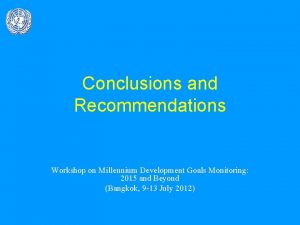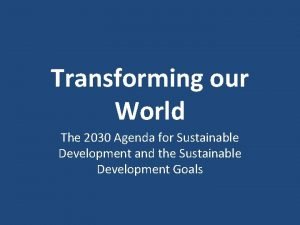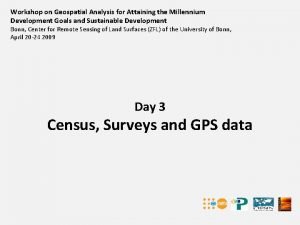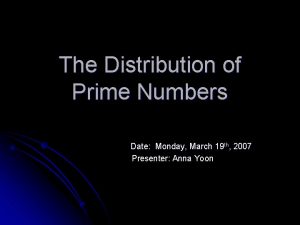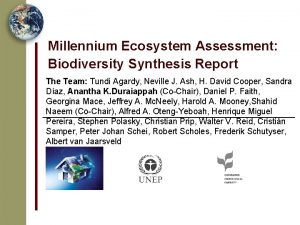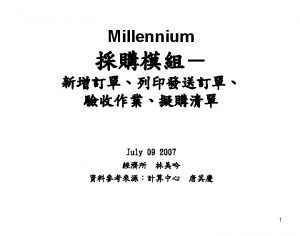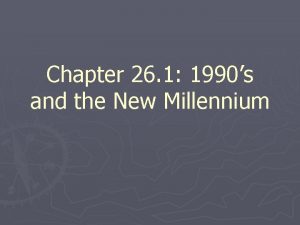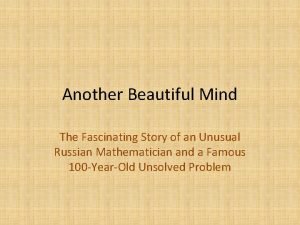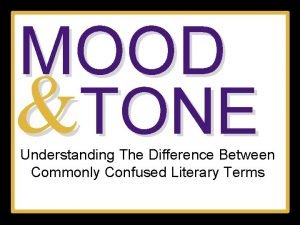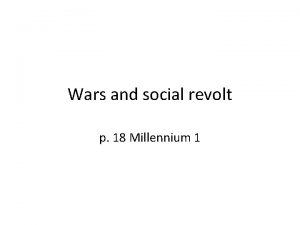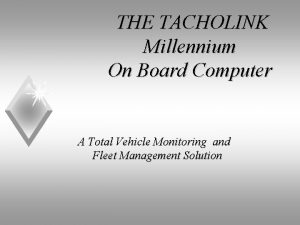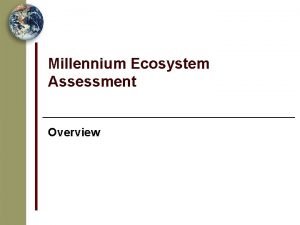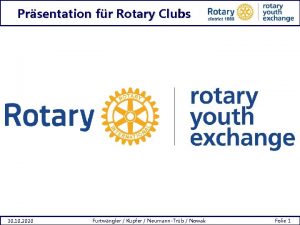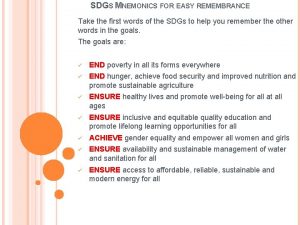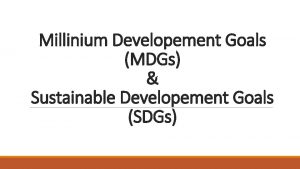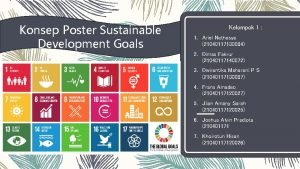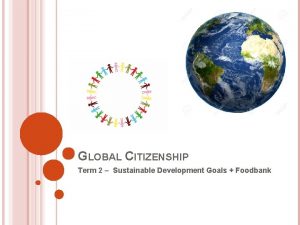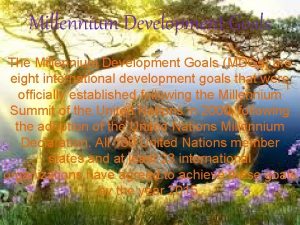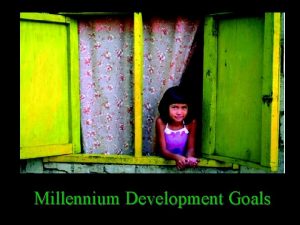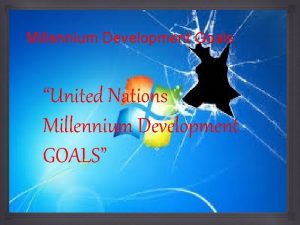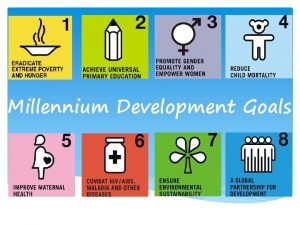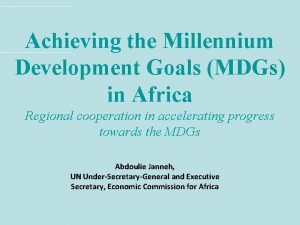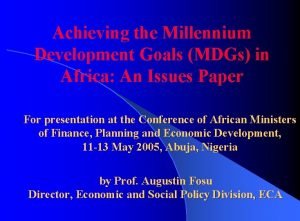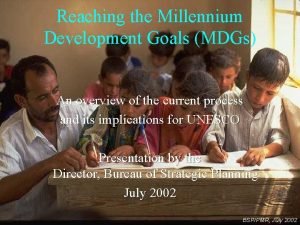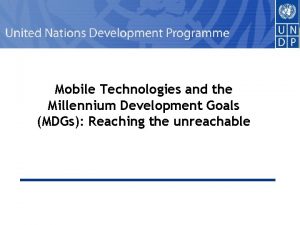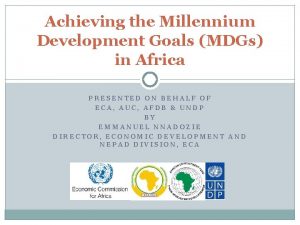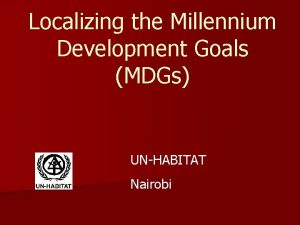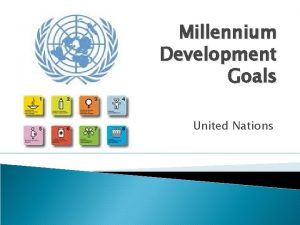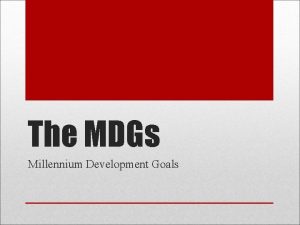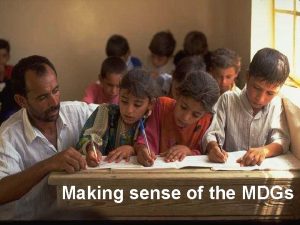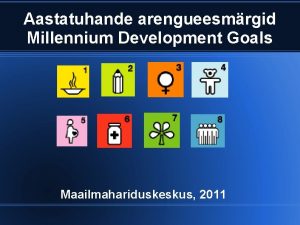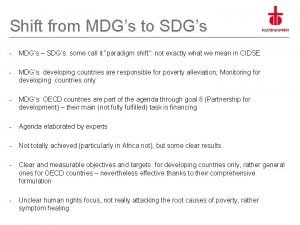The Millennium Development Goals MDGs The eight MDGs


















































- Slides: 50





























The Millennium Development Goals (MDGs) • The eight MDGs break down into 21 quantifiable targets that are measured by 60 indicators • Goal 1: Eradicate extreme poverty and hunger • Goal 2: Achieve universal primary education • Goal 3: Promote gender equality and empower women • Goal 4: Reduce child mortality • Goal 5: Improve maternal health • Goal 6: Combat HIV/AIDS, malaria and other diseases • Goal 7: Ensure environmental sustainability • Goal 8: Develop a Global Partnership for Development

Goal 3: Promote gender equality and empower women • Indicators • Target 3 a: Eliminate gender disparity in primary and secondary education preferably by 2005, and at all levels by 2015 • 3. 1 Ratios of girls to boys in primary, secondary and tertiary education • 3. 2 Share of women in wage employment in the nonagricultural sector • 3. 3 Proportion of seats held by women in national parliament

CEDAW • Convention on the elimination of all forms of discrimination against women • Adopted in 1979 by the UN General Assembly, is often described as an international bill of rights for women • Currently, 185 countries - over ninety percent of the members of the United Nations - are party to the Convention

The Convention defines discrimination against women as • ". . . any distinction, exclusion or restriction made on the basis of sex which has the effect or purpose of impairing or nullifying the recognition, enjoyment or exercise by women, irrespective of their marital status, on a basis of equality of men and women, of human rights and fundamental freedoms in the political, economic, social, cultural, civil or any other field"

HOW – governments who endorsed CEDAW agreed to: • abolish all discriminatory laws and adopt appropriate ones prohibiting discrimination against women • establish tribunals and other public institutions to ensure the effective protection of women against discrimination

In the Chapter on Women in power and decision-making paragraph 189 • "In addressing the inequality between men and women in the sharing of power and decisionmaking at all levels, Governments and other actors should promote an active and visible policy of mainstreaming a gender perspective in all policies and programmes so that before decisions are taken, an analysis is made of the effects on women and men, respectively"

The strategy of mainstreaming is defined in the ECOSOC Agreed Conclusions, 1997/2 • It is a strategy for making women’s as well as men’s concerns and experiences an integral dimension of the design, implementation, monitoring and evaluation of policies and programmes in all political, economic and societal spheres so that women and men benefit equally and inequality is not perpetuated. The ultimate goal is to achieve gender equality" Generic Mandates (ECOSOC 1997/2)

WHAT IS ECOSOC • The Economic and Social Council (ECOSOC) of the United Nations is a group of UN member countries that assists the General Assembly in promoting international economic and social cooperation and development

United Nations General Assembly • The General Assembly of the UN requests the Secretary-General to report annually to the GA, through the Commission on the Status of Women and the Economic and Social Council, on the following:

• Ways to enhance the capacity of the Organization and of the United Nations system in gender mainstreaming • Ways to support the ongoing follow-up to the Fourth World Conference on Women including human and financial requirements

• There is an explicit mandate on gender mainstreaming in the area of peace and security in Security Council resolution 1325( 2000) of 31 October 2000 which clearly outlines all the steps which need to be taken to ensure gender perspectives are given adequate attention in this area of the work of the United Nations

• Specific mandates are also available on bringing gender perspectives to the centre of attention in national budget processes as well as in the development of programme budgets in the United Nations

Is your programme/project concerned about: • • Direct and indirect discrimination Equality and equity (fair or impartial) Women empowerment Gender division of labour - horizontal and vertical segregation - eliminating stereotypes • Gender needs/basic and strategic

Tools – monitoring and evaluation • • Gender analysis Gender planning Gender audit Gender budget and programme evaluation

Build your case • You may need to explain why gender mainstreaming is important: – a Human Rights approach – for sustainable development – Gender equality does not go against the local culture

Accountability • Responsibility for implementation of the gender mainstreaming strategy lies with the senior management in each United Nations entity, as clearly stated in the Letter from the Secretary-General to heads of all United Nations entities in October 1997

• In many parts of the United Nations system Gender Units and Gender Focal Points have been established to support management undertake their roles in implementing gender mainstreaming. Gender Units are staffed with gender specialists

Various Gender bodies • Division for the Advancement of Women – DAW • International Research and Training Institute for the Advancement of Women – INSTRAW • United Nations Development Fund for Women – UNIFEM • Office of the Special Advisor on Gender Issues and Advancement of Women - OSAGI

MONITORING AND EVALUATION • The Special Adviser takes up gender mainstreaming in all missions to entities in the United Nations system and reports on progress to the Secretary-General. Progress reports are also prepared on the work of OSAGI to support gender mainstreaming

UNSSC partners with OSAGI • In mainstreaming gender by: • Developing e-learning course on gender mainstreaming – basic level • Enhancing capacity of experts and professionals • Gaining leadership support through gender mainstreaming mediums

Mediums of ensuring compliance – policy development – Research – advocacy/ dialogue – Legislation – resource allocation – and planning, implementation and monitoring of programmes and projects

Resources: • Inter-Agency Network on Women and Gender Equality – IANWGE • And • Women Watch • http: //www. un. org/womenwatch
 Draw a conclusion about the millennium development goals.
Draw a conclusion about the millennium development goals. Strategic goals tactical goals operational goals
Strategic goals tactical goals operational goals Strategic goals tactical goals operational goals
Strategic goals tactical goals operational goals Millennium goals 2000
Millennium goals 2000 Millennium goals 2000
Millennium goals 2000 Millennium goals 2000
Millennium goals 2000 A polygon with eight sides and eight angles
A polygon with eight sides and eight angles What are the meanings of the eight shapes and eight colors
What are the meanings of the eight shapes and eight colors General goals and specific goals
General goals and specific goals Motivation in consumer behaviour
Motivation in consumer behaviour Millennium geospatial
Millennium geospatial Third millennium
Third millennium Millennium prize problems
Millennium prize problems Millennium ecosystem assessment synthesis report
Millennium ecosystem assessment synthesis report Innopac millennium
Innopac millennium Chapter 26 section 1 the 1990s and the new millennium
Chapter 26 section 1 the 1990s and the new millennium Millennium prize problems
Millennium prize problems Ava fontaine
Ava fontaine Miles villacampa
Miles villacampa Millennium 3 financial services reviews
Millennium 3 financial services reviews Millennium ecosystem assessment
Millennium ecosystem assessment Differnt tones
Differnt tones Millennium
Millennium Millennium
Millennium Millennium clock tower edinburgh
Millennium clock tower edinburgh Millennium planters
Millennium planters Millennium
Millennium Us digital millennium copyright act ethics
Us digital millennium copyright act ethics Biotechnology science for the new millennium
Biotechnology science for the new millennium Tint testa
Tint testa Millennium insurance
Millennium insurance Millennium assessment report
Millennium assessment report Greg knight millennium
Greg knight millennium Millennium ecosystem assessment
Millennium ecosystem assessment Städtereisen nodo district
Städtereisen nodo district Millennium scholars program
Millennium scholars program Footloose definition ap human geography
Footloose definition ap human geography Mnemonic for sdg goals
Mnemonic for sdg goals Millinium goals
Millinium goals Un sustainable development goals
Un sustainable development goals Brian gough
Brian gough Poster sustainable development goals
Poster sustainable development goals Suistainable development goals
Suistainable development goals Sustainable development goals 2
Sustainable development goals 2 Hát kết hợp bộ gõ cơ thể
Hát kết hợp bộ gõ cơ thể Frameset trong html5
Frameset trong html5 Bổ thể
Bổ thể Tỉ lệ cơ thể trẻ em
Tỉ lệ cơ thể trẻ em Chó sói
Chó sói Chụp tư thế worms-breton
Chụp tư thế worms-breton Chúa yêu trần thế alleluia
Chúa yêu trần thế alleluia
